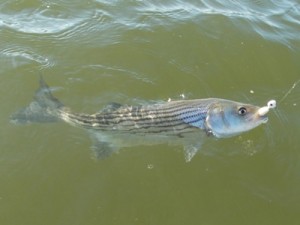
Biologists in Maryland and Virginia recently completed annual surveys of juvenile striped bass and other species in waters of the Chesapeake Bay.
Preliminary results of the surveys suggest that 2018 was a productive spawning season for several iconic fish species, including striped bass, white perch, and American shad.
Maryland
The Maryland Department of Natural Resources (DNR) announced results of its annual young-of-year striped bass survey in Chesapeake Bay, which documented healthy reproduction of the state fish. The 2018 young-of-year index is 14.8, higher than the 65-year average of 11.8.
The Maryland juvenile striped bass survey is conducted annually to measure spawning success and help predict future abundance. The index represents the average number of young-of-year striped bass captured in each sample.
During this year’s survey, department biologists collected more than 36,000 fish of 55 species, including 1,951 young-of-year striped bass. Results show that white perch and American shad also experienced above-average spawning success this spring.
DNR has monitored the reproductive success of striped bass and other fish species in Maryland’s portion of Chesapeake Bay annually since 1954, making it one of the oldest fish community surveys in the nation.
Twenty-two survey sites are located in the four major spawning systems: Choptank, Potomac, and Nanticoke rivers, and the Upper Chesapeake Bay.
Biologists visit each site three times during the summer, collecting fish with two sweeps of a 100-foot beach seine net. The fish are evaluated for age, size and other factors, and then returned to the water.
The Virginia Institute of Marine Science conducts a similar survey in the southern portion of Chesapeake Bay.
source: Maryland Department of Natural Resources
Virginia
Preliminary results from the Juvenile Striped Bass Seine Survey conducted by researchers at the Virginia Institute of Marine Science (VIMS) suggest an average year class of young-of-year striped bass was produced in Virginia tributaries of the Chesapeake Bay in 2018.
The 2018 year class represents the group of fish hatched this spring that can grow to fishable sizes in three to four years, if not claimed by natural mortality.
The program, an ongoing long-term survey, recorded a mean value of 10.72 fish per seine haul in the Virginia portion of Chesapeake Bay, which is similar to the historic average of 7.77 fish per seine haul.
The 2018 value was also similar to indices observed in the past five years. Although there can be considerable variation in striped bass recruitment among years, the average indices observed in recent years suggests that abundance of juvenile striped bass has been stable.
The VIMS Juvenile Striped Bass Seine Survey currently samples 18 index stations in the Rappahannock, York, and James River watersheds.
Biologists sampled each site 5 times from late June to early September in 2018, deploying a 100-foot seine net from the shore. Each fish captured in the net is counted, measured, and returned to the water. These young striped bass usually measure between 1.5-4 inches long.
Survey scientists in Virginia measured 1,875 juvenile striped bass at these stations in 2018. VIMS has been conducting the survey annually since 1967 for the Virginia Marine Resources Commission (VMRC).
The striped bass population in the Chesapeake Bay has rebounded from historic lows in the late 1970s and early 1980s, after fishing bans were enacted in Delaware, Maryland, and Virginia in the mid- to late-1980s. Since then, the population has increased to the point that striped bass in the Bay and elsewhere are now considered recovered.
Striped bass play an important role as a top predator in the Chesapeake Bay ecosystem and are a valuable resource for commercial and recreational anglers.
Professor Mary Fabrizio, who directs the Juvenile Striped Bass Seine Survey at VIMS, notes that the economic and ecological value of striped bass lends significant interest to the year-to-year status of their population.
“By estimating the relative number of young-of-year striped bass,” she says, “our survey provides an important measure of annual and long-term trends in the Bay’s striped bass population.”
source: Virginia Institute of Marine Science
Leave a Reply
You must be logged in to post a comment.